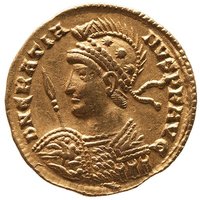
"Gratian (/ˈɡreɪʃən/; Latin: Flavius Gratianus; 18 April 359 – 25 August 383) was emperor of the western part of the Roman Empire from 367 to 383. The eldest son of Valentinian I, Gratian accompanied his father on several campaigns along the Rhine and Danube frontiers and was raised to the rank of augustus in 367. Upon the death of Valentinian in 375, Gratian took over government of the west while his half-brother Valentinian II was also acclaimed emperor in Pannonia. Gratian governed the western provinces of the empire, while his uncle Valens was already the emperor over the east.
Gratian subsequently led a campaign across the Rhine, attacked the Lentienses, and forced the tribe to surrender. That same year, the eastern emperor Valens was killed fighting the Goths at the Battle of Adrianople, which led to Gratian elevating Theodosius to replace him in 379. Gratian favoured Nicene Christianity over traditional Roman religion, issuing the Edict of Thessalonica, refusing the office of pontifex maximus, and removing the Altar of Victory from the Roman Senate's Curia Julia. The city of Cularo on the Isère river in Roman Gaul was renamed Latin: Gratianopolis after him, which later evolved to Grenoble." - (en.wikipedia.org 11.08.2021)





